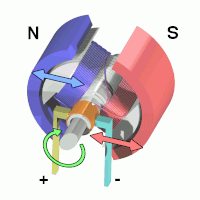
Photo from wikipedia
As neodymium and other rare earth materials become a critical commodity, the exploitation of reluctance torque in synchronous motors is certainly an interesting option. Alternative motor topologies span from internal… Click to show full abstract
As neodymium and other rare earth materials become a critical commodity, the exploitation of reluctance torque in synchronous motors is certainly an interesting option. Alternative motor topologies span from internal permanent magnet motors to pure reluctance machines. Anyway, any anisotropic structure suffers from some magnetic nonlinearities that call for more sophisticated models to get an efficient torque control. Neural network-based algorithms are good candidates for modeling the current-to-flux linkages curves of synchronous reluctance (SynR) motors, but so far their use was limited by the inherent complexity and the computational burden. This paper proposes the use of a special kind of neural networks, namely, the radial basis function networks, to get the magnetic model of any synchronous motor, including saturation and cross-coupling effects. Through experimental evidence, it will be shown that the structure is light enough to be implemented, trained, and self-updated online on standard high-end ac drives. The model is used to track online the maximum torque-per-ampere working point of a SynR motor drive.
Journal Title: IEEE Journal of Emerging and Selected Topics in Power Electronics
Year Published: 2019
Link to full text (if available)
Share on Social Media: Sign Up to like & get
recommendations!